At its best, fashion is joy. A source of beauty and inspiration. It’s the dress that you put on when you want to feel good and the ostentatious red carpet designs that allow you to dream. But fashion can also have an ugly undercurrent, whether it’s environmental destruction and material waste or archaic beauty standards that dictate so-called trends in body types.
Thankfully, we live in a time where people with power in the fashion industry are using it to change things from the inside out. New brands are cropping up with ethical practices baked into their business plans. Up-and-coming designers create with all types of people in mind, no matter size, race, age or gender. Executives meet in boardrooms to discuss pathways for challenging the old ways of doing things.
We’re celebrating some of those changemakers pushing to make the fashion industry a better place, from the faces on the runways to the materials in the ateliers and beyond.
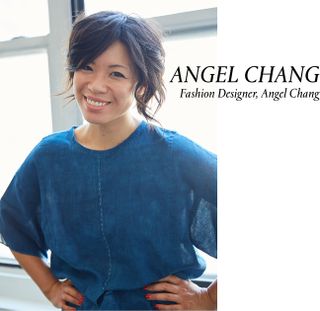
If there’s proof that great things take time to build, it’s Angel Chang’s fashion line. Though she first launched in 2006, the brand has since undergone some seismic shifts to re-emerge as a zero-carbon womenswear line in 2020. That luxury of time is woven into the very fabric of Chang’s clothing, which today is made entirely by hand.
Designing a fashion line without any machinery or electricity involved—the cotton grown from Indigenous seed, the fiber handwoven, the fabric colored with plant dyes, each piece sewn together by hand— seemed like an impossible dream to Chang. And yet she’s making it a reality, working with artisans in the Navajo Nation, Guatemala, Egypt, Mexico, and India to create fashion that is, seed-to-garment, produced by hand with no carbon output.
Chang worked for over eight years to lay the groundwork for her dream, between on-the-ground research and local training programs. She also worked to unlearn the habits and techniques picked up in her traditional fashion training, like following the real seasons over fashion’s imposed seasons and learning to stitch everything—even buttonholes—by hand. For Chang, her designs are more than just clothes: They’re the start of a zero-carbon future.

Real structural changes can take time in the fashion industry—especially inside historic luxury houses like Gucci, where Antonella Centra is working hard to innovate.
Stay In The Know
Marie Claire email subscribers get intel on fashion and beauty trends, hot-off-the-press celebrity news, and more. Sign up here.
Centra holds the title of Executive Vice President General Counsel, Corporate Affairs & Sustainability—and with the support of parent company Kering—Centra and Gucci advocated for Italy’s first circular fashion hub in 2023, fittingly dubbed the Circular Hub. Located in Tuscany, the vision for the Circular Hub is that brands will create the circular products of the future, using recycled materials in the front end and designs planning for reuse at the end of the piece’s lifespan. The Hub will start with Gucci’s production sites, its Italian-based raw material suppliers, and finished products manufacturers, with the plan to eventually open up to other Kering brands and, finally, the entire fashion sector.
Centra also championed Gucci ArtLab, which serves as both a center for experimentation and an artisan school to train future craftspeople. In 2018, the Gucci ArtLab introduced “scrap-less leather” to reduce leather wastage, and Gucci Up, which donates discontinued fabrics to social enterprises.
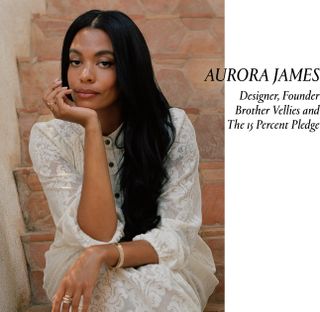
Aurora James was already establishing herself as a leader in the fashion community with her footwear brand, Brother Vellies, founded in 2013. But in the wake of George Floyd’s murder in 2020, James became a trailblazer in the industry, urging major retailers and fashion organizations to commit 15 percent of their purchasing power to Black-owned business. What started as an Instagram call-to-action became a full-blown, non-profit advocacy organization—the Fifteen Percent Pledge—and within 10 days, Sephora became the first brand to officially sign on.
Since then, James and the Fifteen Percent Pledge have signed on 29 companies—including Nordstrom, Bloomingdales, Rent the Runway and more—helping over 625 Black-owned businesses develop relationships with the companies that have taken the pledge. The Pledge has partnered with Google to create the Business Equity Community (BEC), which directly connects Pledge takers with Black entrepreneurs.
It’s been an impressive few years, but James has even bigger goals in mind: By 2030, the Pledge hopes to drive $1.4 trillion of wealth generation by Black entrepreneurs.

When Cartier was looking to hire its first-ever Head of Diversity & Inclusion for North America, the brand found a superstar in Erica Lovett. She’d already spent time at Condé Nast, working her way up in a few short years to become the Director of Inclusion & Diversity for the publisher, where she led initiatives for 18 media brands.
Once Lovett landed at the historic jewelry house in October of 2020, she got to work transforming the culture at Cartier, partnering with the North American leadership team to formulate a meaningful diversity and inclusion roadmap. In 2023, Lovett was instrumental in supporting the brand’s first Diversity, Equity and Inclusion Award at the 16th annual Cartier Women’s Initiative Awards Ceremony, a prize that gives serious financial and social rewards to “businesses offering products or services dedicated to closing gaps of access, outcome or opportunity for communities that have been underrepresented or underserved.”
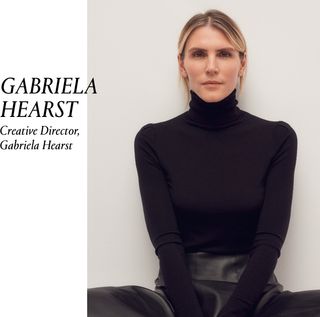
More often than not, the key to garnering success in the fashion industry is finding a way of doing things differently. See, for example, what Gabriela Hearst has done: She launched her first line, Candela, in the early aughts and made beautiful clothes. But it wasn’t until she relaunched under her eponymous label, with a focus on ethical craftsmanship and sustainable materials, that business took off for her. Hearst found herself listed next to brands like Hermès and The Row, and by December 2020, that attention landed her the top spot at French fashion house Chloé.
Though Hearst’s spring/summer 2024 collection at Chloé will be her last, she made her time as creative director count: Under her direction, Chloé worked with the Institut Français de la Mode and Conservatoire National des Arts et Métiers to create a Social Profit and Loss methodology to be shared as an open-source, launched a Fair Trade luxury collection in partnership with the WFTO, and achieved B-Corp certification. Chloé also shared a list of its main partners in an effort towards transparency—a huge and unheard of move in the notoriously secretive fashion industry, where such resources are guarded as trade secrets.
Hearst has kept up the good work at her own brand as well, switching to deadstock materials and staging carbon-neutral fashion shows.
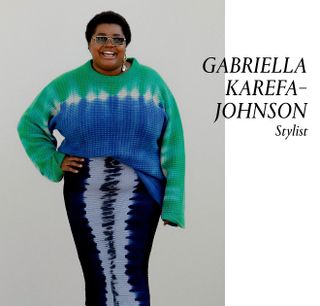
Name an iconic editorial from the past several years, and chances are very good fashion editor and stylist Gabriella Karefa-Johnson is behind it: Think Margot Robbie done up in Barbie pinks, British Vogue’s “New Supers” cover shoot with three iconic plus-size models, Inaugural poet Amanda Gorman in Louis Vuitton by Virgil Abloh on the cover of Vogue.
Of course, Karefa-Johnson learned under some of the industry’s biggest names in fashion styling, like Julia Sarr-Jamois and Tonne Goodman, so it’s no surprise she’s emerging as a star in her own right. What makes her work more compelling than having an outstanding eye for fashion, however, Karefa-Johnson imbues everything she does with joy, from styling Etro runways and Swarovski campaigns to collaborating with Target on a size-inclusive collection and creating a capsule for Weekend Max Mara inspired by her own family. Just seeing her street style photos is enough to bring a smile to your face: Karefa-Johnson knows there’s happiness to be found playing with personal style.
And Karefa-Johnson is using fashion to tell more diverse stories, using her editorials to make the industry more inclusive for all body types, races and ages. She is, quite literally, changing what high fashion moments look like—and, just as importantly, who they include.
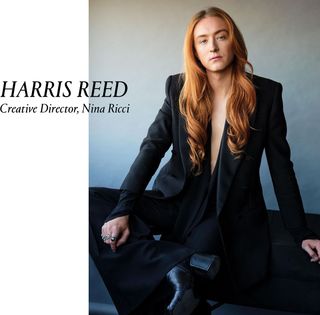
Not many fashion students—not even those at the prestigious Central Saint Martins in London—are recruited by Harry Styles to create custom looks for his tour. But then, not many fashion students are like Harris Reed.
Only in his mid-twenties, Reed is already a fashion phenomenon thanks to his designs which defy gender definition. Adele, Solange, Sam Smith, Beyoncé and Iman have all worn his creations. Gucci’s former creative director Alessandro Michele took Reed under his wing, casting the designer in Gucci’s 2019 Cruise show and bringing him on as an apprentice. All that buzz landed Reed the role of creative director for French fashion house Nina Ricci.
Throughout his ascent, Reed has stayed true to his commitment to fluid fashion, identifying his aesthetic as “Romanticism Gone Nonbinary,” bringing that ethos to a gender fluid collaboration with M.A.C. Cosmetics and a jewelry line with Missoma.
In Reed’s hands, fashion is a tool to blur the lines of gender expression—as chronicled in his upcoming book FLUID: A Fashion Revolution to be released in January 2024.
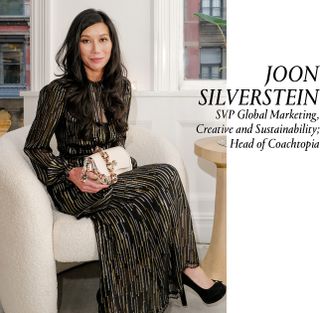
Most fashion brand executives today stop thinking about what happens to their products once they’re in the hands of the consumers, which can lead to lots of waste. Then there’s Joon Silverstein at Coach.
The American brand tapped Silverstein to serve as SVP Global Marketing, Creative and Sustainability and Head of Coachtopia, and it’s that last bit of her title that has made headlines across the industry. Coachtopia is a brand-new sub-brand from Coach focused on circularity, creating handbags from Coach production waste or leather scraps from tanneries, clothing from recycled cotton or deadstock denim, and shoes from recycled polyester and renewable sugarcane soles. Even better, every item is designed with circularity in mind, meaning it can be remade into something new at the end of its life cycle.
In addition to launching Coachtopia, Silverstein helped usher in Coach’s (Re)Loved program, in which old Coach bags are refreshed or repurposed to reduce waste. It’s all par for the course for Silverstein, who has put her MBA from Harvard Business School to use revolutionizing how we think about luxury fashion.
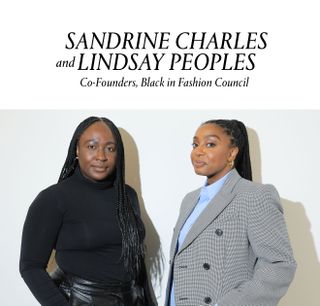
What can happen when you combine the efforts of a masterminded editor and a powerhouse publicist? Incredible industry change, as exemplified by the Black in Fashion Council, the brainchild of The Cut editor-in-chief Lindsay Peoples and public relations specialist Sandrine Charles.
The Black in Fashion Council launched in the summer of 2020 with the goal of representing and securing the advancement of Black individuals across the fashion and beauty industries. It was something already at top of mind for Peoples, who had written a groundbreaking report on what it’s like to be Black in fashion for The Cut in 2018, but the conversation around a lack of inclusivity in fashion exploded following the murder of George Floyd in 2020.
Since its inception, the Council has formed a directory and hosted countless networking events, as well as issuing annual reports. This September, the Black in Fashion Council will present its 7th Discovery Showrooms at New York Fashion Week in partnership with IMG, a space created to highlight emerging Black creatives in the fashion industry.
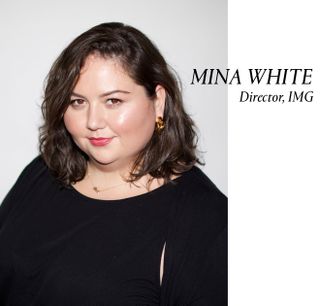
You might not recognize IMG Models’ Mina White in photos; as a Director at the agency, it’s her job to push other faces into the foreground. But you’ve most definitely seen her work—whether it was Hari Nef’s Gucci Bloom campaign, Ashley Graham’s Sports Illustrated: Swimsuit cover or Paloma Elsesser’s stomp down the McQueen runway.
White has been integral to the size inclusivity movement from her perch at IMG Models. In 2014, five models walked into IMG after being released from another agency—those women became the foundation of Curve at IMG Models. Today, White spearheads IMG Models’ size diversity initiatives. When Graham became the first plus-size model to cover the annual SI: Swimsuit issue, it was with White’s guidance, and the agent was pushing casting agents to put Elsesser on their runways during the supermodel’s breakout season in February 2020.
But White has been pushing the boundaries in other ways too. In 2012, she helped model Xiao Wen Juland a Marc Jacobs campaign, the first model of Asian heritage to do so; she’s worked alongside the model-turned-photographer Richie Shazam as she added more hyphenates onto her already-impressive resume. With White advocating for body diversity on the agency side, the future of the fashion industry is looking just a little brighter.

On the hunt for dresses to wear on her honeymoon, Ngozi Okaro met seamstress Mariama. Operating out of her home, Mariama whipped up two of the best dresses Okaro had ever owned—but she also knew that Mariama wasn’t charging nearly enough for her incredible work. After working with Mariama to develop a business plan that would help her thrive, Okaro was inspired to build a community to help other women just like her, and Custom Collaborative was born. The organization connects fashion-industry workers, primarily immigrant and low-income women, who are seeking fair compensation with thoughtful consumers who want quality clothes made sustainably.
In addition to running Custom Collaborative, Okaro is also a Commissioner of the NYC Equal Employment Practices Commission and a Director of the NYC Economic Development Corporation, accumulating a spate of distinctions and awards for her work as an activist for economic, environmental, and social justice.
Coming next: This fall, Custom Collaborative will launch its “On the Move” campaign, celebrating the successes of the many, many women Custom Collaborative has worked with since it launched in 2016. The organization will also be moving into a bigger space, where it can teach more subjects to more people and grow the community Okaro created even larger.
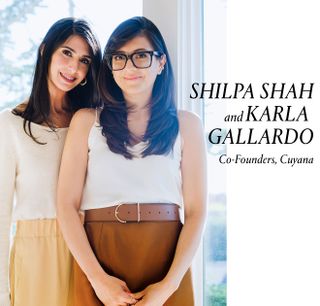
Over a decade ago, Shilpa Shah and Karla Gallardo founded the brand Cuyana around the philosophy of “fewer, better”—the promise that investing in timeless, well-made pieces would not just make for better wardrobes, but for a better world, too. Shah, the brand’s Chief Experience Officer, came from the world of designing web and mobile interfaces before earning her MBA at the UC Berkeley Haas School of Business; Gallardo traded a career at Goldman Sachs for an MBA from the Stanford Graduate School of Business, where Cuyana was officially born.
Together, they’ve built Cuyana into a go-to brand for customers looking for sleek, sophisticated and sustainable pieces to add to their wardrobe. Shah and Gallardo work in partnership with local artisans, hailing from Peru to Italy, combining their artisanship with luxurious materials to create collections of pieces meant to seamlessly combine together. The brand is also working towards circularity with programs like Cuyana Revive, in which old pieces can be given new life, and a partnership with resale site ThredUp.
2023 is shaping up to be the most exciting year for the brand yet: This summer, Cuyana reached its goal of using 100-percent sustainably-made materials across its product collections. A big win, to be sure, but ultimately just another stop along Cuyana’s long-term sustainable journey; 100-percent carbon-neutral packaging is the next goal in mind.

-
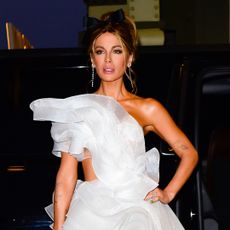 Kate Beckinsale Says Never-Ending Claims She's Had "Unrecognizable Surgery" is Taking a "Toll"
Kate Beckinsale Says Never-Ending Claims She's Had "Unrecognizable Surgery" is Taking a "Toll""...it happens constantly and it’s usually women that are doing it."
By Danielle Campoamor Published
-
 Eva Mendes Shares Sweet Post in Support of Ryan Gosling and His New Movie
Eva Mendes Shares Sweet Post in Support of Ryan Gosling and His New Movie"Do you believe in happy endings?"
By Danielle Campoamor Published
-
 King Charles, Queen Camilla and Royal Family Members Take Over the Late Queen's Former Patronages
King Charles, Queen Camilla and Royal Family Members Take Over the Late Queen's Former PatronagesBuckingham Palace announced a "major review" of over 1,000 royal Patronages and charity Presidencies.
By Danielle Campoamor Published